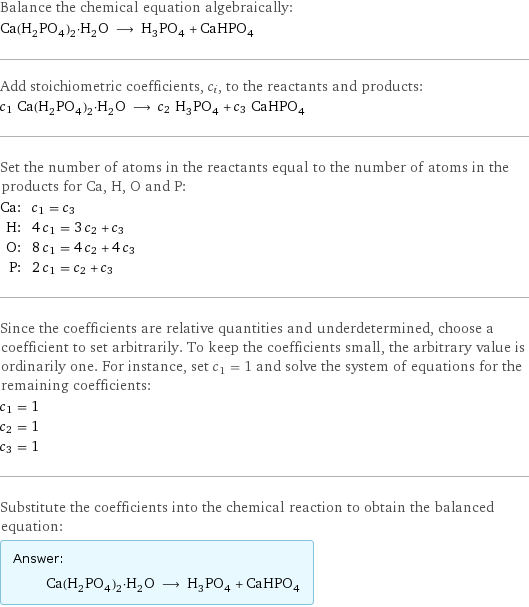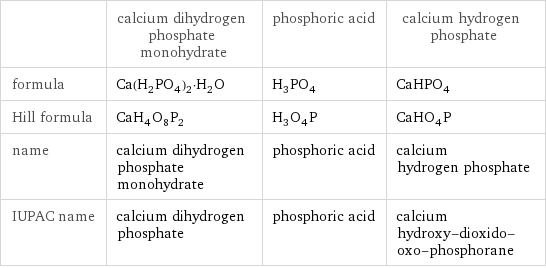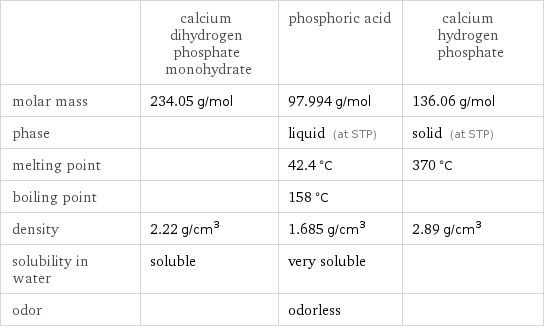Input interpretation

Ca(H_2PO_4)_2·H_2O (calcium dihydrogen phosphate monohydrate) ⟶ H_3PO_4 (phosphoric acid) + CaHPO_4 (calcium hydrogen phosphate)
Balanced equation

Balance the chemical equation algebraically: Ca(H_2PO_4)_2·H_2O ⟶ H_3PO_4 + CaHPO_4 Add stoichiometric coefficients, c_i, to the reactants and products: c_1 Ca(H_2PO_4)_2·H_2O ⟶ c_2 H_3PO_4 + c_3 CaHPO_4 Set the number of atoms in the reactants equal to the number of atoms in the products for Ca, H, O and P: Ca: | c_1 = c_3 H: | 4 c_1 = 3 c_2 + c_3 O: | 8 c_1 = 4 c_2 + 4 c_3 P: | 2 c_1 = c_2 + c_3 Since the coefficients are relative quantities and underdetermined, choose a coefficient to set arbitrarily. To keep the coefficients small, the arbitrary value is ordinarily one. For instance, set c_1 = 1 and solve the system of equations for the remaining coefficients: c_1 = 1 c_2 = 1 c_3 = 1 Substitute the coefficients into the chemical reaction to obtain the balanced equation: Answer: | | Ca(H_2PO_4)_2·H_2O ⟶ H_3PO_4 + CaHPO_4
Structures

⟶ +
Names

calcium dihydrogen phosphate monohydrate ⟶ phosphoric acid + calcium hydrogen phosphate
Equilibrium constant
![Construct the equilibrium constant, K, expression for: Ca(H_2PO_4)_2·H_2O ⟶ H_3PO_4 + CaHPO_4 Plan: • Balance the chemical equation. • Determine the stoichiometric numbers. • Assemble the activity expression for each chemical species. • Use the activity expressions to build the equilibrium constant expression. Write the balanced chemical equation: Ca(H_2PO_4)_2·H_2O ⟶ H_3PO_4 + CaHPO_4 Assign stoichiometric numbers, ν_i, using the stoichiometric coefficients, c_i, from the balanced chemical equation in the following manner: ν_i = -c_i for reactants and ν_i = c_i for products: chemical species | c_i | ν_i Ca(H_2PO_4)_2·H_2O | 1 | -1 H_3PO_4 | 1 | 1 CaHPO_4 | 1 | 1 Assemble the activity expressions accounting for the state of matter and ν_i: chemical species | c_i | ν_i | activity expression Ca(H_2PO_4)_2·H_2O | 1 | -1 | ([Ca(H2PO4)2·H2O])^(-1) H_3PO_4 | 1 | 1 | [H3PO4] CaHPO_4 | 1 | 1 | [CaHPO4] The equilibrium constant symbol in the concentration basis is: K_c Mulitply the activity expressions to arrive at the K_c expression: Answer: | | K_c = ([Ca(H2PO4)2·H2O])^(-1) [H3PO4] [CaHPO4] = ([H3PO4] [CaHPO4])/([Ca(H2PO4)2·H2O])](../image_source/b46353463c1a18a01a03525787378994.png)
Construct the equilibrium constant, K, expression for: Ca(H_2PO_4)_2·H_2O ⟶ H_3PO_4 + CaHPO_4 Plan: • Balance the chemical equation. • Determine the stoichiometric numbers. • Assemble the activity expression for each chemical species. • Use the activity expressions to build the equilibrium constant expression. Write the balanced chemical equation: Ca(H_2PO_4)_2·H_2O ⟶ H_3PO_4 + CaHPO_4 Assign stoichiometric numbers, ν_i, using the stoichiometric coefficients, c_i, from the balanced chemical equation in the following manner: ν_i = -c_i for reactants and ν_i = c_i for products: chemical species | c_i | ν_i Ca(H_2PO_4)_2·H_2O | 1 | -1 H_3PO_4 | 1 | 1 CaHPO_4 | 1 | 1 Assemble the activity expressions accounting for the state of matter and ν_i: chemical species | c_i | ν_i | activity expression Ca(H_2PO_4)_2·H_2O | 1 | -1 | ([Ca(H2PO4)2·H2O])^(-1) H_3PO_4 | 1 | 1 | [H3PO4] CaHPO_4 | 1 | 1 | [CaHPO4] The equilibrium constant symbol in the concentration basis is: K_c Mulitply the activity expressions to arrive at the K_c expression: Answer: | | K_c = ([Ca(H2PO4)2·H2O])^(-1) [H3PO4] [CaHPO4] = ([H3PO4] [CaHPO4])/([Ca(H2PO4)2·H2O])
Rate of reaction
![Construct the rate of reaction expression for: Ca(H_2PO_4)_2·H_2O ⟶ H_3PO_4 + CaHPO_4 Plan: • Balance the chemical equation. • Determine the stoichiometric numbers. • Assemble the rate term for each chemical species. • Write the rate of reaction expression. Write the balanced chemical equation: Ca(H_2PO_4)_2·H_2O ⟶ H_3PO_4 + CaHPO_4 Assign stoichiometric numbers, ν_i, using the stoichiometric coefficients, c_i, from the balanced chemical equation in the following manner: ν_i = -c_i for reactants and ν_i = c_i for products: chemical species | c_i | ν_i Ca(H_2PO_4)_2·H_2O | 1 | -1 H_3PO_4 | 1 | 1 CaHPO_4 | 1 | 1 The rate term for each chemical species, B_i, is 1/ν_i(Δ[B_i])/(Δt) where [B_i] is the amount concentration and t is time: chemical species | c_i | ν_i | rate term Ca(H_2PO_4)_2·H_2O | 1 | -1 | -(Δ[Ca(H2PO4)2·H2O])/(Δt) H_3PO_4 | 1 | 1 | (Δ[H3PO4])/(Δt) CaHPO_4 | 1 | 1 | (Δ[CaHPO4])/(Δt) (for infinitesimal rate of change, replace Δ with d) Set the rate terms equal to each other to arrive at the rate expression: Answer: | | rate = -(Δ[Ca(H2PO4)2·H2O])/(Δt) = (Δ[H3PO4])/(Δt) = (Δ[CaHPO4])/(Δt) (assuming constant volume and no accumulation of intermediates or side products)](../image_source/20819ada72def946b85b710a2b900d68.png)
Construct the rate of reaction expression for: Ca(H_2PO_4)_2·H_2O ⟶ H_3PO_4 + CaHPO_4 Plan: • Balance the chemical equation. • Determine the stoichiometric numbers. • Assemble the rate term for each chemical species. • Write the rate of reaction expression. Write the balanced chemical equation: Ca(H_2PO_4)_2·H_2O ⟶ H_3PO_4 + CaHPO_4 Assign stoichiometric numbers, ν_i, using the stoichiometric coefficients, c_i, from the balanced chemical equation in the following manner: ν_i = -c_i for reactants and ν_i = c_i for products: chemical species | c_i | ν_i Ca(H_2PO_4)_2·H_2O | 1 | -1 H_3PO_4 | 1 | 1 CaHPO_4 | 1 | 1 The rate term for each chemical species, B_i, is 1/ν_i(Δ[B_i])/(Δt) where [B_i] is the amount concentration and t is time: chemical species | c_i | ν_i | rate term Ca(H_2PO_4)_2·H_2O | 1 | -1 | -(Δ[Ca(H2PO4)2·H2O])/(Δt) H_3PO_4 | 1 | 1 | (Δ[H3PO4])/(Δt) CaHPO_4 | 1 | 1 | (Δ[CaHPO4])/(Δt) (for infinitesimal rate of change, replace Δ with d) Set the rate terms equal to each other to arrive at the rate expression: Answer: | | rate = -(Δ[Ca(H2PO4)2·H2O])/(Δt) = (Δ[H3PO4])/(Δt) = (Δ[CaHPO4])/(Δt) (assuming constant volume and no accumulation of intermediates or side products)
Chemical names and formulas

| calcium dihydrogen phosphate monohydrate | phosphoric acid | calcium hydrogen phosphate formula | Ca(H_2PO_4)_2·H_2O | H_3PO_4 | CaHPO_4 Hill formula | CaH_4O_8P_2 | H_3O_4P | CaHO_4P name | calcium dihydrogen phosphate monohydrate | phosphoric acid | calcium hydrogen phosphate IUPAC name | calcium dihydrogen phosphate | phosphoric acid | calcium hydroxy-dioxido-oxo-phosphorane
Substance properties

| calcium dihydrogen phosphate monohydrate | phosphoric acid | calcium hydrogen phosphate molar mass | 234.05 g/mol | 97.994 g/mol | 136.06 g/mol phase | | liquid (at STP) | solid (at STP) melting point | | 42.4 °C | 370 °C boiling point | | 158 °C | density | 2.22 g/cm^3 | 1.685 g/cm^3 | 2.89 g/cm^3 solubility in water | soluble | very soluble | odor | | odorless |
Units
